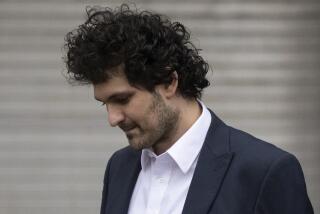Op-Ed: The stranger-than-fiction story of how the Fed was created

People walk past the Marriner S. Eccles Federal Reserve Board Building in Washington, D.C. on June 19.
According to opinion surveys, no institution save the Internal Revenue Service is held in lower regard than the Federal Reserve. It’s also a font of conspiracy theories stoked by radical libertarians, who insist the Fed is debauching the currency and will ultimately bankrupt the country.
The Fed’s unpopularity would make sense if it had, say, failed to intervene and save the system during the 2008 financial crisis. But, in fact, the Fed did rescue the economy.
Its reputation would likewise make sense if it were jacking up interest rates, foisting hardship on ordinary Americans. But the Fed has maintained a low rate policy, stimulating the economy while keeping the dollar strong and inflation low.
For central bank watchers, this dynamic -- effective policy rewarded with populist scorn -- is nothing new. In America, it has always been thus.
Nonetheless, dissatisfaction is alive in Congress, where various bills would strip the Fed’s autonomy and subject sensitive monetary decisions to the scrutiny of elected politicians. Some bills would go even further and explore a return to the gold standard.
For central bank watchers, this dynamic — effective policy rewarded with populist scorn — is nothing new. In America, it has always been thus.
At Alexander Hamilton’s urging, Congress first chartered a national bank — the ur-Fed — in 1791. However, Thomas Jefferson, who famously mistrusted banks (he thought agriculture more virtuous), and who was fearful of a strong central government, opposed this development. After 20 years, the Jeffersonians won and Congress let the charter expire.
This decision led to disaster: ruinous inflation. So Congress chartered a Second Bank of the United States, which began in 1817, providing the growing country with a better, more uniform currency and improved its public finances. But success couldn’t save it. Andrew Jackson despised the Second Bank as a tool of East Coast elites, and it too was abolished.
For most of the 19th century, the U.S., unlike most nations in Europe, did not have a lender of last resort. Frequent panics and credit shortages were the result. Yet some of the very people who could have benefited most from a central bank, such as farmers who were starved for credit, preferred the status quo. Like Jackson and Jefferson before them, they were fearful that a government bank would tyrannize the people, perhaps in cahoots with Wall Street.
After a financial panic in 1907 virtually shut down the banking system, reformers began to press once more for a central bank. But popular mistrust remained so pronounced that they were afraid to go public.
This is the point — 105 years ago — when the story seems to have been hijacked by a future Hollywood scriptwriter.
On a November evening in 1910, a powerful senator, Rhode Island Republican Nelson W. Aldrich, boarded his private rail car near New York. A light snow was falling, muting the hushed, conspiratorial tones of his guests, which is exactly how Aldrich wanted it.
The reform-minded banker Paul Warburg, one of his guests, was toting a hunting rifle, but he had no interest in hunting. The party also included a member of the powerful Morgan bank, as well as an assistant U.S. Treasury secretary, and Frank Vanderlip, head of the country’s largest bank, National City.
“On what sort of errand are we going?” Vanderlip inquired.
“It may be a wild-goose chase; it may the biggest thing you and I ever did,” Warburg replied.
Masquerading as duck hunters, they disembarked in Brunswick, Ga., and traveled by launch to Jekyll Island, home of an exclusive club surrounded by pine and palmetto groves. Over the course of a week, Aldrich and his bankers mapped out a draft of what was to become the Federal Reserve Act, changing the U.S. economy forever.
Congress was never told that Aldrich’s bill had been drafted by Wall Street moguls. His bill did not pass, but it was the basis of a successor bill, the Federal Reserve Act, which Woodrow Wilson signed in 1913. Years later, when the Jekyll trip was revealed to the public, extremists seized on this stranger-than-fiction episode to bolster their claim that the Fed was a bankers’ plot against the American people. For conspiracy theorists, the bankers’ conclave on Jekyll became a metaphor for the Fed itself. The obvious irony is that, fearing Americans’ irrational suspicion of central banking, Aldrich and his crew resorted to a plot that, ultimately, deepened the country’s paranoia.
Despite their clandestine tactics, the financiers’ motives were actually patriotic. Aldrich had visited Europe and studied its central banks. He wanted expert help to draft an American equivalent. And in between sumptuous meals featuring wild turkey and freshly scalloped oysters, his group of wealthy bankers earnestly wrestled with issues that still provoke us today: How should power over the economy be apportioned between Washington and localities? How should the central bank set interest rates and the money supply?
The Federal Reserve today is not perfect. But it is more transparent than ever, thanks to reforms instituted by the previous chairman, Ben S. Bernanke, and it is no less necessary than was a central bank in 1791. Americans’ paranoia is unjustified, just as it has always been.
Roger Lowenstein is the author of the newly published “America’s Bank: The Epic Struggle to Create the Federal Reserve.”
Follow the Opinion section on Twitter @latimesopinion and Facebook
More to Read
A cure for the common opinion
Get thought-provoking perspectives with our weekly newsletter.
You may occasionally receive promotional content from the Los Angeles Times.





